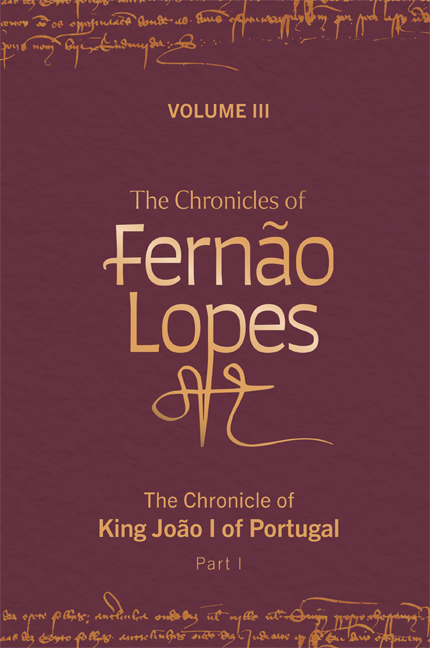Chapter 155 - How the King of Castile reached Santarém and placed governors in a number of towns
Published online by Cambridge University Press: 28 December 2023
Summary
The king departed from Torres Vedras as you have heard, and reached Santarém with his wife. Not yet completely recovered, she was conveyed in a litter, with the Prince of Navarre leading the draught-horses by the reins. There, the king started to plan how the places that supported him should remain secure and defended. On a Monday, there was a muster in Valada [do Ribatejo], to see what people he had to assign, both those who were to remain in each place and those he was to take with him. The muster yielded but a few people, poorly equipped as men in retreat after a siege; also, most of them had lost to death the lords with whom they had come.
In Santarém, the king removed the governor Lope Fernández de Padilla in order to take him back to Castile, and left Diego Gómez Sarmiento, his brother, in the town as Officer of the Marches; whereas he ordered Gómez Pérez de Valderrábano to remain in the fortress with a good 800 lances and 300 crossbowmen. In Sintra, he left Count Enrique Manuel; in Torres Vedras, a Castilian knight whom people called Juan Duque; in Alenquer, Vasco Peres de Camões; in Óbidos, João Gonçalves Teixeira; in Leiria, García Rodríguez Taborda, who had been King Fernando's chief justice; and in Torres Novas, Alfonso López de Tejada, a native Castilian who was a grand commander of the Order of Santiago, in order to take with him Gonçalo Vasques de Azevedo, on whom he played a good trick, which we shall recount in this chapter.
He left the Count of Viana in charge of Penela and Miranda [do Corvo], and in other towns he kept there those who already held them, as we have explained where appropriate, or put others in their place, as was the case with Prior Pedro Álvares when he left with the king, and the latter placed a number of men in the fortified places within the lands of his priory to guard them.
- Type
- Chapter
- Information
- The Chronicles of Fernão LopesVolume 3. The Chronicle of King João I of Portugal, Part I, pp. 315 - 318Publisher: Boydell & BrewerPrint publication year: 2023

